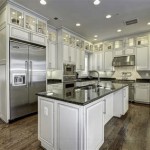Can You Mix Painted and Stained Cabinets? A Comprehensive Guide
The question of mixing painted and stained cabinets is a complex one, often debated among homeowners and interior designers alike. There's no definitive "yes" or "no" answer. The viability of this design choice hinges on numerous factors, including the overall aesthetic goal, the specific colors and wood tones involved, the architectural style of the space, and the level of design expertise applied. This article will explore the considerations involved in successfully integrating painted and stained cabinetry, providing insights into how to achieve a cohesive and visually appealing outcome.
Understanding the Appeal of Mixed Cabinetry
The rising popularity of mixed cabinetry stems from a desire for personalized and visually dynamic spaces. Monochromatic kitchens, while sometimes elegant, can lack character and depth. Mixing painted and stained cabinets introduces visual interest, allowing for the highlighting of specific areas, the creation of focal points, and the infusion of warmth and texture through natural wood grains. This approach allows for a more nuanced and tailored design, reflecting the homeowner's unique style preferences and lifestyle.
Furthermore, mixing cabinets can be a practical solution when renovating or remodeling. Existing cabinetry might only need a partial upgrade; staining existing wood cabinets while painting others can be a more cost-effective alternative to replacing the entire set. This approach also allows for the retention of cherished wood features while modernizing the overall look of the kitchen or bathroom.
The trend also aligns with a broader movement towards eclectic and personalized interior design. Homeowners are increasingly embracing individuality and moving away from rigid, cookie-cutter aesthetics. Mixing cabinet finishes provides a powerful tool for expressing personal style and creating spaces that feel both comfortable and visually engaging.
Key Considerations for Successful Integration
Successfully mixing painted and stained cabinets requires careful planning and attention to detail. A haphazard approach can result in a disjointed and unappealing aesthetic. The following factors should be carefully considered before embarking on such a project:
*Color Palette and Tone:
The colors chosen for painted cabinets must harmonize with the wood tones present in the stained cabinets. Choosing complementary or analogous colors can create a cohesive and balanced look. Consider the undertones of both the paint and the stain. For example, a warm-toned wood stain pairs well with warm-toned paint colors like creams, yellows, or oranges. Conversely, a cool-toned wood stain might complement cool grays, blues, or greens. The level of contrast between the paint and stain should also be carefully considered. High contrast can create a bold and dramatic look, while low contrast promotes a more subtle and understated aesthetic. *Wood Grain and Texture:
The type of wood used for stained cabinets significantly impacts the overall look. Woods with prominent grain patterns, such as oak or hickory, create a more rustic and textured feel. Smoother woods, like maple or cherry, offer a more refined and contemporary aesthetic. The grain pattern should be a deliberate design choice and should complement the style of the painted cabinets. In some cases, using painted cabinets to contrast with the natural wood grain can add visual interest, while in other situations, it's better to choose a paint color that blends in with the wood's undertones. *Architectural Style:
The architectural style of the home should guide the design choices made regarding cabinet finishes. In a traditional home, combining stained wood cabinets with painted cabinets in neutral colors can create a classic and timeless look. In a modern or contemporary home, bolder color combinations and contrasting wood tones might be more appropriate. Farmhouse styles often incorporate painted cabinets in light, muted colors paired with natural wood islands or accent pieces. *Cabinet Placement and Functionality:
The placement of painted and stained cabinets should be strategic and purposeful. For example, using stained cabinets for lower cabinets and painted cabinets for upper cabinets can create a sense of visual lightness and airiness. Islands are often stained to create a focal point and add warmth to the space. Consider the functionality of each cabinet when deciding on the finish. Cabinets that are frequently touched or used in high-traffic areas might benefit from a more durable paint finish. *Hardware and Accessories:
The hardware chosen for both painted and stained cabinets should be consistent in style, finish, and scale. Using the same hardware throughout the kitchen or bathroom helps to tie the different finishes together and create a unified look. Other accessories, such as countertops, backsplashes, and lighting fixtures, should also complement both the painted and stained cabinets.Achieving a successful mix of painted and stained cabinets requires a holistic approach that considers all of these factors in relation to one another.
Examples of Successful Mixed Cabinetry Designs
Examining successful examples of mixed cabinetry designs can provide inspiration and guidance. Here are a few common scenarios:
*Painted Perimeter Cabinets with a Stained Island:
This is a popular and versatile design choice. Painting the perimeter cabinets in a light, neutral color creates a bright and airy feel, while staining the kitchen island in a contrasting wood tone adds warmth and visual interest. The island can then serve as a focal point within the space. *Stained Lower Cabinets with Painted Upper Cabinets:
This design approach can create a sense of visual balance, as the stained cabinets ground the space while the painted cabinets lighten the upper portion of the kitchen. This setup works well in kitchens with high ceilings or limited natural light, as the lighter upper cabinets reflect light and create a more open feel. *Painted Cabinets with Stained Accent Pieces:
Incorporating stained wood accents, such as open shelving, range hoods, or pantry doors, can add character and texture to a kitchen with primarily painted cabinets. This approach is often used in farmhouse or rustic-style kitchens to introduce natural wood elements without overwhelming the space. *Two-Tone Painted Cabinets with a Stained Island:
This design involves using two different paint colors for the cabinets, such as a light color for the upper cabinets and a darker color for the lower cabinets. Adding a stained island to this design further enhances the visual complexity and creates a truly custom and personalized look.These examples demonstrate the versatility of mixed cabinetry designs and highlight the importance of considering the specific characteristics of each space when making design choices.
Potential Challenges and How to Overcome Them
While mixing painted and stained cabinets can yield stunning results, it's important to be aware of the potential challenges involved and how to overcome them:
*Achieving Color Harmony:
Selecting paint and stain colors that complement each other can be challenging. Utilizing color swatches, paint decks, and online color palettes is essential. Test paint and stain samples in the actual lighting conditions of the kitchen or bathroom before making a final decision. Consulting with a color expert or interior designer can also be beneficial. *Ensuring Visual Cohesion:
Preventing the design from appearing disjointed requires careful attention to detail. Consider using consistent hardware and accessories throughout the space to tie the different finishes together. Repeating elements, such as the same countertop material or backsplash tiles, can also help to create a cohesive look. *Maintaining a Consistent Style:
Mixing cabinet finishes should be done in a way that enhances the overall style of the home. Avoid combining finishes that clash stylistically. For example, pairing sleek, modern painted cabinets with rustic, distressed stained cabinets might create a jarring and incongruous effect. *Managing Wood Grain Variations:
Variations in wood grain and texture can affect the appearance of stained cabinets. Be sure to select wood species with similar grain patterns and color variations to create a more uniform look. Using a wood conditioner before staining can help to minimize blotchiness and ensure even color absorption.Addressing these challenges proactively can help to ensure a successful and visually appealing outcome.

Mixing Stained And Painted Kitchen Cabinets

Mixing Stained And Painted Kitchen Cabinetry Is A Winning Recipe

Elevate Your Kitchen With Mixed Cabinets

Your Kitchen Mix Wood And Painted Finishes

Combining Paint And Stain Kitchen Cabinets Burrows Builder Direct

Mixing Finishes With Style Premium Cabinets

Kitchen Trend Wood Stained And Painted Cabinets Home Bunch Interior Design Ideas

Painted Vs Stained Cabinets Which Fits Your Style Best

Mixing Stained And Painted Kitchen Cabinets

A Fresh Bathroom Mix Painted Cabinets Stained Trim
Related Posts








